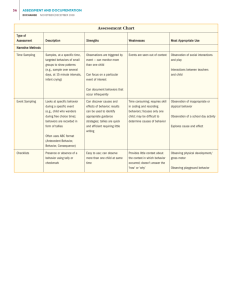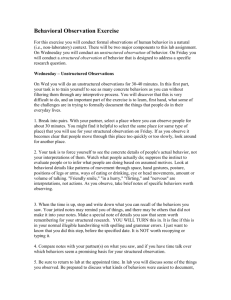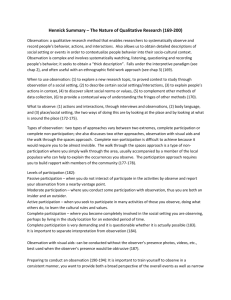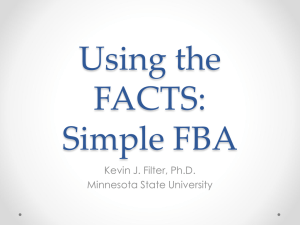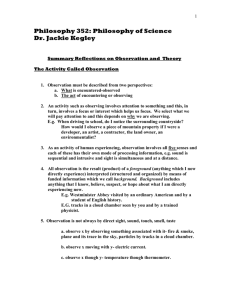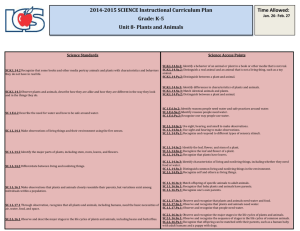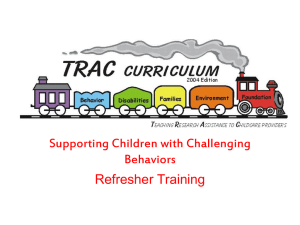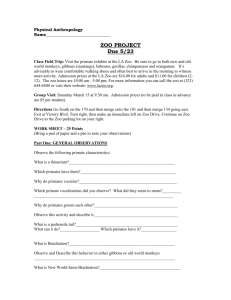How to Observe Children - Wayne Community College
advertisement
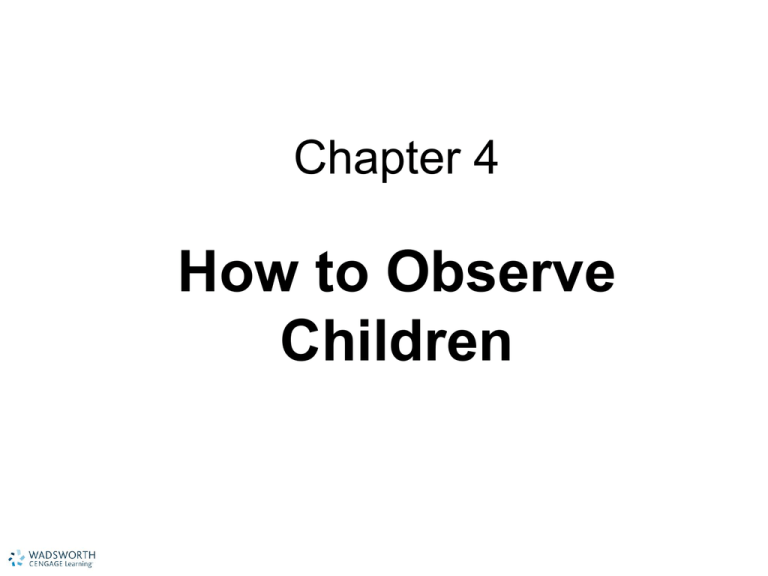
Chapter 4 How to Observe Children What Is Observation? • Clues to the development and personality of each child • To “read” the child • To “see” a situation • To develop a child sense • Important role in assessment Why Observe? • Improve your teaching • Use as an assessment tool – Become more objective and less biased, and use less inference • Construct theory – Link research to practice – Develop specific goals and objectives for planning and development • Assist families – Share meaningful examples of abilities Why Observe? (cont.) • Wonder why and solve a problem – A time of reflections – Developing hunches and intuition – Rethinking the problem Contexts for Understanding Observations • Children as individuals – Tailoring what a child is ready and willing to learn – Report what a child does (not feels) and interpretations • Children in general – Look at developmental norms – Children’s play patterns evolve – Understanding group and individual behavior Influences on Behavior • Environmental influences are classroom arrangement, daily schedule, and the activities themselves • Transitions and time of day impact behavior • Relationships between children and adults Understanding Self • Notice human behavior more accurately • One teaches children and learns from them • Capturing the unique personality, culture, and qualities develops selfawareness Key Elements of Observation • Systematic observations aid in recording events and help teachers make sense of them • Must develop a “language of recording” to practice • Elements of observation – – – – Focus on what you want to know Develop a system Find a tool or instrument Select the environment Types of Observation • Narratives – Record nearly everything that happens – Baby biography, diary, journal, or log – Modified running record or specimen description (one thing at a time) – Advantages: • rich information, detailed behavioral accounts, take notes at any time – Disadvantages: • time consuming, tendency for judgment or inference Observation Strategies— Anecdotal Record • Detailed record of specific episode of particular interest or concern • A short descriptive story about a child’s specific behavior event that is of particular interest or concern. – This may be firsthand information as observed by child care providers or recorded from secondhand information as provided by parents. – It is qualitative, not quantitative data. Observation Strategies— Running Account • Specific type of behavior noted each time it occurs to provide ongoing description of behavior Samplings • Time sampling – What happens at a given time – Less descriptive – Recorded at regular intervals – Can use a checklist – Advantage: focus on specific behaviors – Disadvantage: difficult to get the whole picture • Event sampling – Defines an event and devises a system to encode immediately – Looks at specific behaviors using checklists a number of times during a day – Advantage: clearly defined with a recording sheet – Disadvantage: lack of detail from a narrative Observation Strategies— Time Sampling • Identifies behaviors • Determines patterns of occurrence and general frequency of behaviors Observation Strategies— Event Sampling • Determines pattern of occurrence and precise number of times predetermined behavior occurs within set period of time Rating Methods • Checklists with predetermined data are simple to make and record but lack rich detail • Rating scales are checklists planned in advance that measure quantity and quality How to Observe and Record Effectively • Observing while teaching – Gather and prepare materials – Consider where you will observe – Plan when it will take place, and arrange help if needed – Prepare every adult to be an observer and reflect on children’s play How to Observe and Record Effectively (cont.) • Beginning to observe – Plan and establish a time and place – Be unobtrusive – Observe and record – Interpret your data – Act on what you observed Observation Sequence • Determining learning and developmental goals • Watching and recording behavior • Inferring meaning from behavior • Evaluating progress toward learning and developmental goals • Planning changes to enable achievement of desired goals Observation • Qualitative information- Unmeasurable descriptive qualities and characteristics of behaviors. • Quantitative information- Measurable numerical data and statistical calculations that tell how often or to what degree behaviors occur Inferring Meaning • Act of drawing conclusions from evidence perceived by one’s senses or through communication Biases • Biases are one’s own set of beliefs, values, perceptions, and assumptions • Biases develop from one’s upbringing, past experience, and personal philosophy of life • All we perceive with our senses is filtered through layers of our personal point of view (bias) Perceive • Become aware of subtle impressions about the physical world by focusing on the senses to notice and understand • Make the effort to separate facts from opinions to increase objectivity • We see children differently because we are different
